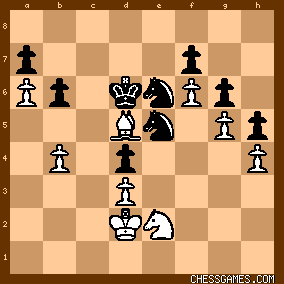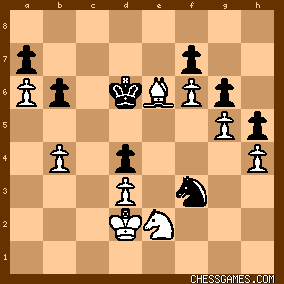| offramp: Williams was a very strong player, but he only beat Mr Harrwitz twice while losing 17 games to him. This win is a little lucky. White gains space in the opening, mainly on the kingside. But those of us that have done that know that in an endgame those "space-gaining" pawns can be very weak. But things are more or less level throughout. Then something rather unusual happens. 40...Kd6

click for larger view
This attacks the bishop. so White plays 41.Bxe6. But Black does not recapture immediately. He takes a punt with a Zwischenzug: 41...Nf3+.

click for larger view
I would imagine that Harrwitz, like most of us, didn't think much of this check, except to think that his king must move to d1, c1 or c2 and it doesn't really matter which. Perhaps without thinking he played 42.Kc2??
In fact, the only move after 41...Nf3+ that stays in the game is 42.Kd1! But why? Well, Black is going to take that white bishop on e6, and white can then check him with Nf4+. From f4 the knight has access to d5 (counter-attacking) and g2 (defending; specifically defending h4). Black's winning attempt would be based on ...Kf5, ...Kg4, ...Kxh4, ...Kxg5.
White's counterplay is based on Nd5 and Nxb6! followed later by b4-b5, Nc4 and b5-b6. With the king on d1 we have this variation:

click for larger view
42. Kd1 Kxe6 43. Nf4+ Kf5
(43... Kd6 44. Ng2 Ke5 45. Ke2=)
44. Nd5 Nxh4
(44... Kg4 45. Nxb6 Nxh4 46. b5 Ng2 47. Nc4 h4 48. b6 h3 49.Ne5+ =) 45. Nxb6 Ng2 46.Ke2

click for larger view which looks like a draw. What have I learned? Essentially, that white should have kept his king in the square of the black h-pawn! So, not much! | 




